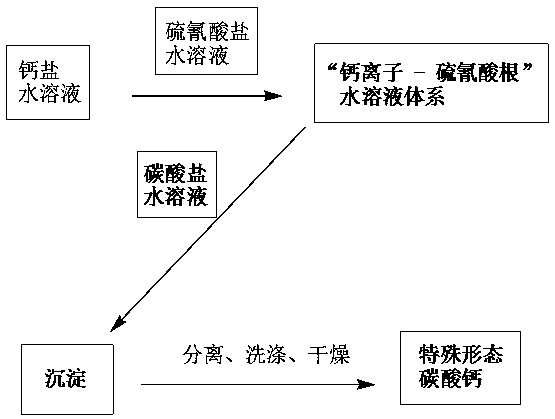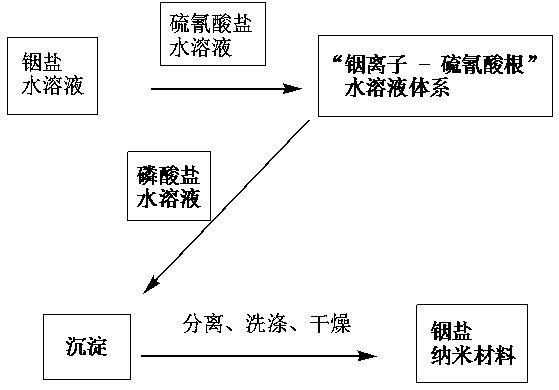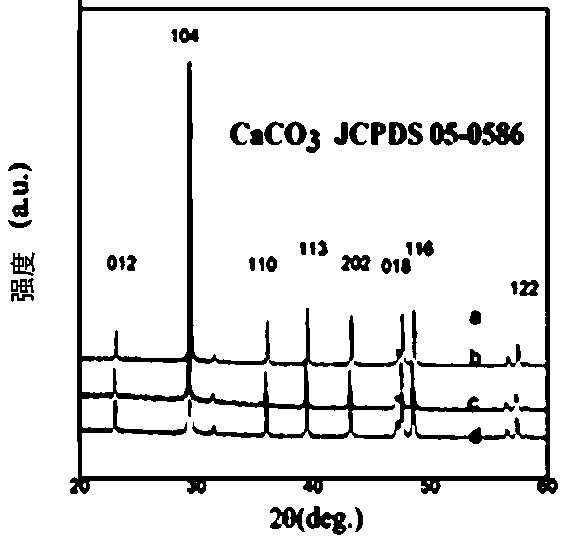Insoluble inorganic salt micro-nano material as well as preparation method and application thereof
A technology of water-soluble inorganic salts and nano-materials, applied in the direction of inorganic chemistry, chemical instruments and methods, gallium/indium/thallium compounds, etc., can solve the problems that nano-scale materials are not easy, and achieve simple preparation methods, easy production, The effect of simple process
- Summary
- Abstract
- Description
- Claims
- Application Information
AI Technical Summary
Problems solved by technology
Method used
Image
Examples
Embodiment 1
[0037] 50 mL of 0.1 mol / L CaCl 2 After mixing the aqueous solution and 150 ml of NaSCN aqueous solution with a concentration of 0.1 mol / L in a beaker, add 100 ml of NaSCN with a concentration of 0.1 mol / L 2 CO 3 The aqueous solution is added dropwise into a beaker and left standing for 2 to 4 hours. The product is separated by filtration, washed three times with deionized water, dried in an oven at 60° C., and set aside.
[0038] Powder X-ray diffraction (XRD) analysis confirmed the product to be calcium carbonate. As shown in the curve b in Fig. 3.
[0039] The SEM image shows that the calcium carbonate is a cubic micron-sized particle with a smooth surface, as shown in the b image in Figure 4.
Embodiment 2
[0041] 50 mL of 0.5 mol / L CaCl 2 The aqueous solution and 150 ml of NaSCN aqueous solution with a concentration of 0.5 mol / L were mixed uniformly in a beaker, and then 100 ml of NaSCN with a concentration of 0.5 mol / L 2 CO 3 The aqueous solution is added dropwise into a beaker and left to stand for 2 to 4 hours. The product is separated by filtration, washed three times with deionized water, dried in an oven at 60°C, and set aside.
[0042] Powder X-ray diffraction (XRD) analysis confirmed the product to be calcium carbonate. As shown in the curve c in Fig. 3.
[0043] SEM images show that calcium carbonate is a quasi-cubic micron-sized particle with a rough surface, which is stacked by sheet-like structures, as shown in image c in Figure 4.
Embodiment 3
[0045] 50 mL of 2 mol / L CaCl 2 After mixing the aqueous solution and 150 ml of NaSCN aqueous solution with a concentration of 2 mol / L in a beaker, add 100 ml of NaSCN with a concentration of 2 mol / L 2 CO 3 The aqueous solution is added dropwise into a beaker and left to stand for 2 to 4 hours. The product is separated by filtration, washed three times with deionized water, dried in an oven at 60°C, and set aside.
[0046]Powder X-ray diffraction (XRD) analysis confirmed the product to be calcium carbonate. As shown in the curve d in Fig. 3.
[0047] SEM images show that there are a large number of quasi-spherical and ellipsoidal micro-particles in calcium carbonate, which are stacked by sheet-like nanoscale structures, as shown in the d image in Figure 4.
PUM
 Login to View More
Login to View More Abstract
Description
Claims
Application Information
 Login to View More
Login to View More - R&D
- Intellectual Property
- Life Sciences
- Materials
- Tech Scout
- Unparalleled Data Quality
- Higher Quality Content
- 60% Fewer Hallucinations
Browse by: Latest US Patents, China's latest patents, Technical Efficacy Thesaurus, Application Domain, Technology Topic, Popular Technical Reports.
© 2025 PatSnap. All rights reserved.Legal|Privacy policy|Modern Slavery Act Transparency Statement|Sitemap|About US| Contact US: help@patsnap.com



